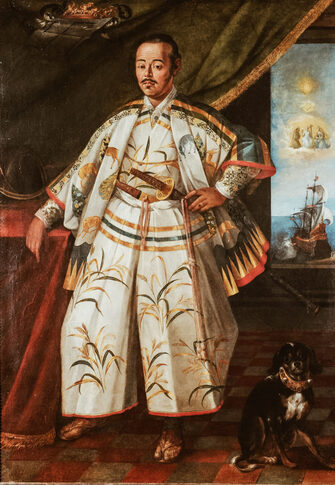 c. 1615. Hasekura’s portrait by French Baraoque painter Claude Deruet. Look at this dapper gentleman, at his neatly pressed wardrobe, at his swords jauntily positioned at his hip; look at the casualness of his stance. Now, study the painting behind him, the dog at his feet, the curtains and flooring. Take notice of the striking differences in light and shadow, the rich colors between the foreground and background. The painting itself does not appear to be of Asian origin, does it? Are you confused? This painting has all the elements of a Baroque painting, a European cultural movement that swept the region in the 17 and 18th centuries. Yes, that’s right – European. This portrait is of Hasekura Tsunenaga (支倉六右衛門常長), a Japanese samurai and retainer of a regional ruler of Japan who founded the modern-day city of Sendai, Japan. At a time when the nation of Japan was beginning its persecution and suppression of Christianity within its borders, Hasekura ventured to Europe as head of the Keichou Embassy. Subsequently, he became the first Japanese ambassador in the Americas and Spain. With the encouragement of famous Spanish explorer Sebastian Vizcaino and the go-ahead from both the shogun of Japan and the regional ruler of Sendai, a galleon – a large, Spanish ship – was constructed. It set sail for Spain in October 1613. In addition to taking Spanish explorer Vizcaino back home, Hasekura’s objective was to discuss trade relations with Spain and Rome. In January 1614, the ship arrived in Acapulco, Mexico for a brief reprieve. Upon leaving for Spain in June, Hasekura took only half of his crew; those left in Mexico were instructed to continue trading. Hasekura, now traveling with a fleet of other merchant ships en route to Spain, arrived in October 1614, exactly a year after leaving Japan. The samurai was greeted by carriages, accommodations, and wide-eyed onlookers. Hasekura met with King Philip III in Madrid that following January. He remitted to the King a letter from his lord, the regional ruler of Sendai, and offered a treaty upon which King Philip III responded that he would try his best to accommodate the Japanese’s requests. Thereafter, Hasekura traveled to Italy to meet with Pope Paul V in Rome. He gave the Pope two gilded letters (one in Japanese and the other in Latin) which contained requests for a trade treaty between Mexico and Japan as well the dispatchment of Catholic missionaries to Japan. The Pope readily agreed to the latter of the two requests but could make no decision regarding trade as that was for the King of Spain to decide. Hasekura returned to Spain where King Philip III immediately declined to sign the trade agreement, stating that the Japanese Embassy didn’t appear to be official as it was the eastern nation’s ruler Tokugawa Ieyasu who, in just the previous years, had begun expelling missionaries from Japan and persecuting all those who practiced the Christian faith. By the time Hasekura returned to Japan, the nation had greatly changed. In the short amount of time Hasekura had been gone, the extreme persecution of Christians had been carried out and the nation was on its way to complete isolation which it would continue until the mid-1800s. Hasekura’s return was not joyous nor triumphant. Although he brought back goods and products from the West, he had failed to obtain a trade treaty from Spain. He reported his travels to the lord of Sendai, presenting him gifts from the esteemed rulers he had met as well as goods he had collected. Overall, Hasekura’s adventure was a failure. After several years of travel and careful diplomatic meetings, he brought back nothing for his country. The Japanese emissary himself, however, received many personal gifts during his travels. He was named a Roman Noble and a Roman Citizen. In Havana, Cuba where his ship had stopped briefly, a bronze statue was erected of him. Hasekura was baptized by King Philip III’s personal chaplain and made godchild of the de facto ruler of Spain, the Duke of Lerma. How’s that for creating a name for himself?
0 Comments
Leave a Reply. |
Kara WilsonOwner/Editor of Emerging Ink Solutions, avid YA/NA author, adamant supporter of the Oxford Comma, anime and music enthusiast. Archives
February 2024
|
 RSS Feed
RSS Feed
